Geophysical Observations
What lies beneath the surface of the Earth has remained a mystery until technology allowed us to take a 'look' at what is going on down there. We can only gather information about the internal structure of the Earth through indirect means since we cannot physically travel through its depths. It is hard to believe that more than 2000 km beneath your feet lies the Earth's core - a molten mass of metals and sulfides circulating around a solid center. Have you ever wondered what exactly lies below the Earth's surface? Earth's interior plays a very important role in shaping our planet. It serves as an internal heat engine that powers the motion of the pieces of Earth's hard, brittle surface, the lithosphere (central to a concept called plate tectonics which we will learn about later). A layer called the mantle consists of dense minerals in a state that resembles that of a soft plastic. The motion of materials in the core is thought to produce the magnetic field that protects the Earth's surface from intense solar and galactic radiation. The motion of the plates at the surface results in mountain building. While we would not have earthquakes, the Earth would have a rather boring topography without plate tectonics. Volcanoes, while also rather destructive, release large amounts of nutrients into the biosphere which help our agricultural efforts.
|
Eggs: good food for geological thought
One of the best physical models for our planet is a hard boiled egg. The Earth is even slightly egg shaped, being somewhat wider just south of the equator.
The shell of the egg is analogous to the crust of the Earth. If we crack it up slightly, the model would be even better as the Earth's lithosphere (of which the crust is a part) is broken up into a collection of separate plates. The thickness of the egg shell is just about what the Earth's brittle lithosphere would be if we shrunk the Earth down to the size of an egg (shades of Men in Black).
The white of the egg is analogous to the Earth's mantle. It is about the right relative thickness, and has something of the rather plastic physical state that we know the mantle to have. If the egg's white had a slightly uncooked layer just below the very outer edge, the model would be even better. This layer in the mantle is called the asthenosphere. It allows the separate pieces of the hard, brittle outer part of the Earth to move around. This would be a real trick to pull off in a cooked egg.
The yolk of the egg is analogous to the Earth's core. In a perfect egg-Earth model, the outer half of the egg yolk would be runny and under-cooked as the outer part of the Earth's core is in the liquid state. Clearly, I will have to investigate alternate ways of cooking eggs!
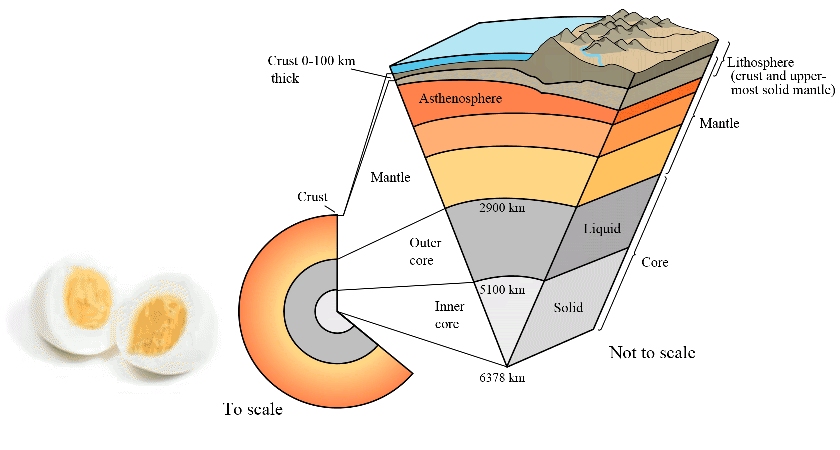
|
Geophysics and Remote Sensing
The two most important means by which information is transmitted from deep within the earth is by sound (seismology) and heat (thermal geophysics). There are other methods in use and we can even look at geometric information at the surface to infer the configuration of rock layers below the surface, but none of these methods allow is to see into the earth as far as sound and heat.
Seismology
How do we know so much about the Earth's interior? We cannot obtain samples from the Earth's interior directly, so how is it that scientists know about all these internal layers? They use indirect observations and measurements. The most useful of these are seismic waves: basically sound vibrations that are produced by earthquakes, explosions, and any other violent impact on the Earth's surface. As these vibrational waves pass through the different layers, they are refracted (bent), reflected, and alter their speed. Seismologists document these in the seismic waves after they pass through the Earth and return to the surface.
The properties of sound waves in rock (the speed of the waves is one of the most useful properties) are determined by the properties of the rocks and minerals (density, compressibility, elasticity, physical state...) which are in turn determined by the minerals present, how the different mineral grains are arranged, and the temperature and pressure they are experiencing. Because of these relationships, one can learn a lot about the minerals, rocks, and conditions at various depths within the earth by studying how sound (seismic) waves pass through the earth.
Once seismic waves are generated by an earthquake, they are detected by seismograph stations that are situated all over the world. A seismograph is an instrument that records the arrival of waves generated by earthquakes. These stations generate data that help scientists determine the location and intensity of an earthquake.

Seismic Waves
There are two types of seismic waves that pass through the body of the earth.
P waves are just like sound waves in air. The particles of the material they pass through vibrate back and forth along the direction that the wave propagates. These waves can pass through any substance. In solid rock, P wave speeds range from about 5 to 10 kilometres per second near the surface.
S waves are sound waves in which the vibration of the particles is perpendicular to direction that the wave is moving. This is somewhat like the wave motion in a vibrating string. S waves can only pass through solids as they need an elastic connection between particles. Even partial melting of a substance reduces the speed of an S wave and attenuates its amplitude. S waves are about half the speed of P waves in any solid medium.
Click here for a more detailed and graphical description of seismic waves.
Seismic wave paths
Seismic waves reflect and refract as they encounter boundaries between different substances in the earth (such as between the mantle and outer core). They also are bent as they pass through the earth because as the density of rock increases with depth, the speed of these waves also increases.

Click here to observe how seismic waves move through the Earth's interior. As you watch this video, notice how the different wave types are influenced by the properties of each layer: reflecting off boundaries, bending as the rock density changes, and being blocked completely in some circumstances. IRIS (Incorporated Research Institutions for Seismology) has a wide variety of interesting seismology videos both on their website and on youtube.
S-waves arrive after the P-waves as they are slower, but they have a greater amplitude and are more destructive.
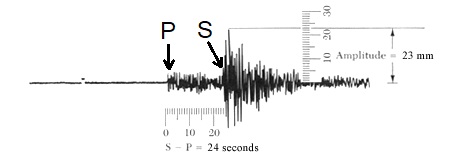
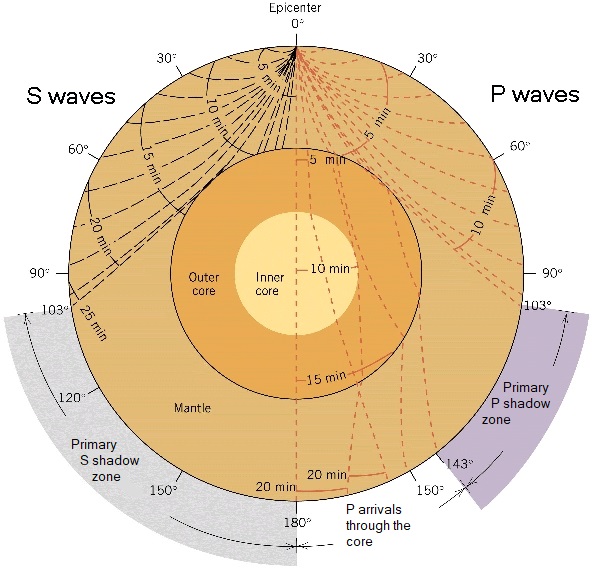
As the previous video pointed out, the shadow zones do eventually get S-wave and P-wave arrivals from waves that reflect back and forth off the different boundaries. They can be distinguished from the direct-path waves by their relative arrival times. If you are interested, check out this link for a guide of the seismic waves that bounce around in the earth after an earthquake.
Outer Core
What evidence do the video and the diagram above show that indicates the presence of a liquid layer deep within the earth?
1) P-waves slow down in liquids and the arrivals for P-waves on the far side of the earth are delayed.
2) P-waves would refract inward at a boundary where they cross from a solid into a slower liquid at an angle. This would explain the P-wave shadow.
3) S-waves cannot pass through a liquid. This would explain the S-wave shadow.
4) The size of the shadow zone corelates with the outer radius of the liquid layer.
The earth's magnetic field also indicates the presence of a liquid metallic layer. A conductive circulating liquid is necessaary for a geomagnetic field.
Luckily, although earthquake waves pass through much of the earth, their amplitude attenuates and the period increases so that on the other side of the earth we don't notice them, much. The 2004 December 26 earthquake in the western Indian ocean resulted in a terrifying tsunami in the Indonesian city of Banda Ache earthquake on the island of Sumatra produced ground motions of almost 2 centimetres on the other side of the Earth in Ottawa. The period of each vibration was 40 seconds, so nobody noticed. These signals took 16 minutes to pass through the earth from Indonesia to Ottawa.
As nasty and destructive as these events are, the signals that they generate, as they are received by seismic sensors all over the world, can be integrated together to produce a fairly clear image of the internal structure of the whole planet.
Our understanding of the seismic wave speeds coupled with the existence of the seismic wave shadows and the overall mass (we know this from the orbital speed of its satellites), and thus, the average density of the earth allows us to work out the composition of the different layers. From these compositions and our knowledge of their physical states, we can work out what the temperature of each layer must be. For example, we know that the core must be an Iron, Nickel, sulfide mixture to account from the Earth's average density and from the make-up of asteroids in this part of the solar system. We also know what the mantle is made of from our knowledge of its seismic wave speeds. Since the outer core is liquid (it does not conduct S waves) and the inner mantle is solid, we know that the temperature of this transition must be below the mantle material melting point and above the core material melting point (calculated for the pressure at that depth).
|
Layers of the Earth
The layers of the Earth are separated based on their physical properties (density, physical state) and their chemical properties (elemental composition, complexity of the silica molecular lattice).
There are two different and overlapping classifications: one based primarily on composition (crust/mantle) and one based more on physical state (lithosphere/asthenosphere/transition zone). It is important to keep these two classifications straight in your mind as you complete the readings below.
Crust/Mantle Boundary
The boundary between the crust and the mantle of the Earth is marked by a sharp change in chemical composition. The crust is made up of less dense minerals with larger and more complex molecular lattice structures. It is up to 40 km thick on the continents and up to 10 km think under the oceans. The mantle has denser minerals with simpler lattice structures. The boundary between the crust and mantle is called the Mohorovicic discontinuity (Moho). Oceanic crust is more dense and more similar to the composition of the mantle. The Moho is easily identified from seismic evidence as there is a sharp increase in the seismic wave speed at this transition. Seismic waves traveling along curved paths through the upper mantle reach distant seismic stations much sooner than waves that follow a shallower path through the crust.
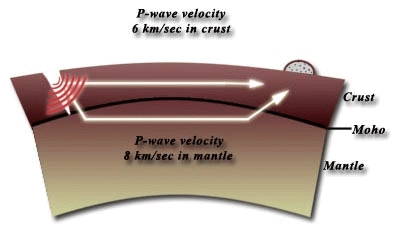
Lithosphere/Asthenosphere Transition
The lithosphere is the hard, brittle outer shell of the Earth. It is made up of the crust and outer part of the mantle. It is up to 250 km think in total (less than half that under the oceans). Under the lithosphere is the asthenosphere: a layer that is much softer and, so, it exhibits a reduction in the seismic wave speed and a loss of amplitude in S waves. It is about 700 km thick in total, with a zone of partially molten (rather similar to plasticine in its physical state) from about 200 to 250 km depth. It has this state because of its high temperature and lower pressure than the rest of the mantle below. The asthenosphere gradually transitions into the lower mantle.
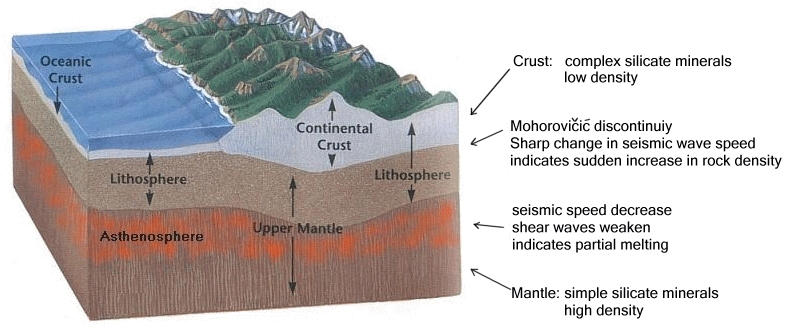
Thermal Geophysics
We will look at this in greater detail after we are done with a sismology project. For now, here is a brief introduction.
Explaining the Physical State of the Earth's Layers
The temperature of the earth increases with depth. There are several sources of thermal energy responsible for this temperature increase.
- Radioactive decay of unstable isotopes within the earth is responsible for most of the thermal energy released.
- Leftover thermal energy from the impact and compression of accreting (in-falling) meteorites during the formation of the earth.
- Leftover thermal energy released as abundant heavy metals (iron, nickel, copper) descended to the Earth's core (losing gravitational potential energy).
- Latent thermal energy released as the liquid outer core crystallizes at the inner core boundary.
There may be some heating from tidal forces as the Earth gets distorted as it rotates under the gravitational attraction to the moon and sun.
As far as geophysicists and geologists are able to estimate the temperature gradient within the Earth, it looks something like the black line in the graph below.
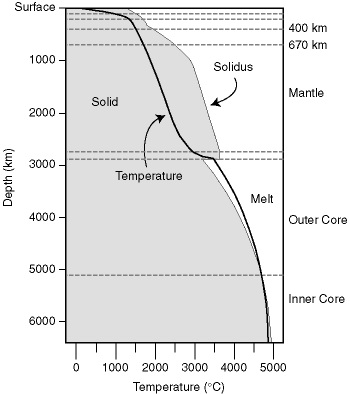
From: Michigan Technological University: Volcanic Heat
Click the link if you are interested in learning more about the thermal structure of the earth.
The edge of the grey zone is an estimate of the change in melting point with depth. I would have thought that the change in composition at the core/mantle boundary would cause a greater change in melting point. It may be that the effect of the enormous pressure at this depth (140 GPa as opposed to the 100 kPa that we experience here on the surface) is much more significant for the melting point than the composition of the materials. The steep increase in temperature at the core/mantle boundary is not something that I had thought would be present, but on further refection, it makes some sense. The liquid metallic core should be very good at conducting and convecting thermal energy upwards to the mantle, but the mantle is likely a better insulator than the outer core, since it is solid and rocky.
Temperature increases very rapidly with depth in the rigid lithosphere at the Earth's surface because it can only conduct, it cannot convect at all. Rock is a really good insulator rather than a conductor of thermal energy. Once the temperature gets high enough to make the rock soft and able to convect (circulate vertically) it can move thermal energy upward much faster so the mantle becomes much more uniform in temperature and temperature increases much less rapidly with depth. Geothermal Gradient Video
Because the melting point of rock decreases as the pressure decreases, the melting point and the temperature are fairly close to each other at the asthenosphere. This is the reason for the partial melting that takes place here which allows for the motion of the Earth's tectonic plates across its surface.
All of this thermal energy eventually reaches earth's surface. Since rock is such a good insulator and since the surface of the earth is large, the actual thermal energy flow is fairly small: 90 mW/m2. This is 15,000 times less then the rate that solar light energy reaches the earth's surface (an average of 1368 W/m2).
|
Other Resources
- http://www.geo.mtu.edu/UPSeis/why.html
- http://pubs.usgs.gov/gip/interior/






